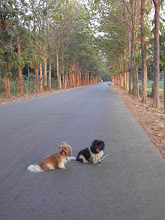
We don't have sure evidence about history of Thai silk that explain when is the first time we made Thai silk, but we know to made silk or textile is one of most ancient handicraft in the world because it began until prehistoric times. In Thailand, fabric weaving has been practiced since prehistoric times and rural society has regarded it as a woman's duty during spare time after work in the fields. The development of both colors and designs of the finished products have been a result of the weavers' own imagination and a long heritage as well as some other factors. In the old days fabrics were a kind of status symbol; there were fabrics for the common people to be used either everyday or on special occasions like merit-making, traditional rituals or important festivities, fabrics for the upper class including the king and the royal family and finally those for the Buddhist monks.
Thai fabrics have a great number of designs, usually distinguished by region. Northern women have been considered very skillful weavers, especially of cotton fabrics. They started by weaving for domestic use and then produced for export as well. It is said that during the twentieth and twenty-first century BE the northern part of Thailand which was known as the Lan Na Kingdom produced many good fabrics for sale in neighbouring states, some of which were Pha Si Chan Khao, Pha Si Chan Daeng, Pha Si Dok Champa etc.. During the Sukhothai Period, about 700 years ago, besides the ordinary coloured ones, a five-colour fabric was produced, commonly known as Pha Benjarong. Different groups of people then produced their own fabrics; court people for example would make fabrics for themselves and ordered some fabrics from abroad. As history has it, silk began to be imported from China during that time. Besides clothing, people began to use fabrics for other purposes such as home decoration (long flags) and other household items (pillows, mattresses, curtains). Fabrics during the Ayudhya Kingdom which was about 400 years ago assumed another important role besides materials for clothing and decoration-they were used as money. They were sometimes given by the king instead of money for rewards and often for the annual remuneration, hence the term Pha Wad Raipee
Thai silk is the heritages of Thai dress cultural succeed for over 3,000 years until now. The art of making silk originated in northeastern Thailand, where cloth weaving is a traditional craft and expansion to upper North. After that Thai silk’s been spread to all of Thailand’s part. Now, Thai silk is called the most famous heritages of Thailand. Patterns and designs depend on each region and local unique.
Producing and selling places

Most of the silk products you'll find in stores, especially in the United States, most likely come from one of these three countries. There are basically two methods of producing the silk. One is by hand, which is mostly done in Thailand, and another is by machine, which is done in Japan and China. The cost of silk products from these countries is very high because of the technology involved. That is one of the reasons why silk is such a valued commodity, especially in the United States.
How Thai silk is made?
All the silk using a rather complicated process. Although there are now many enormous, automated factories making silk fabric all over the world, women weavers at their homes in Northeast Thailand using traditional methods and their own looms. This is why the cloths are unique.
What's the difference between machine woven and hand woven Thai silk?
Every piece of hand woven Thai silk is a timeless, unique work of textile art from the hands of a rural Thai woman. Since it is art work produced by a human, it forever carries thoughts, emotions, feelings, spirit and life of the weaver. Machine woven silk is a wider and sometime is more suitable than hand-woven silk.
Today, there are number of silk companies in and around Bangkok. However, northeast is still the major region of silk production. The company founded by Jim Thompson near the Northeastern town of Pak Thong Chai. There is the largest hand weaving facility in the world. Silk from Thailand can be purchased not just in local shops but throughout the world.
Thai silk products includes Thai silk scarves, Thai silk shawls, necktie, Thai silk handbags, purses , silk pillow, Thai silk table runners, and Thai silk cushion covers.
Method to maintain silk
1. Should clean silk by dry-clean solution in soft type, shouldn't clean silk by powdered detergent. It will be better if use dry-clean solution in especially silk.
2. Shouldn't clean silk by washing machine, because it's make silk crumpled that hard to iron.
3. Shouldn't dry silk in the strong sunlight, because that make silk's color to pale. Should dry in a place where open-air and soft sunlight.
4. Before iron silk should squirt the iron solution which especially silk, and iron in carefulness.
5. If silk is very crumpled, should take it in refrigerator and steep it about 10 -15 minutes. This way will make silk easy to iron.
references
http://www.tsquarewedding.com/index.php?lay=show&ac=article&Id=538732251&Ntype=4
http://www.silkthailand.com/articles/mainarticle2.htm
http://www.panyathai.or.th/wiki/index.php/%E0%B8%9C%E0%B9%89%E0%B8%B2%E0%B9%84%E0%B8%AB%E0%B8%A1%E0%B9%84%E0%B8%97%E0%B8%A2
By
Supunsa Meeboon HS. CHI 513081066-4
Narisa Kumsuwan HS.JP 513080700-1

The 2nd picture's textiles are beautiful!
ReplyDeleteDo you usually wear silk products?
We usually wear silk products in formal ceremony like wedding ceremony and religious ceremony.
ReplyDeleteGreat content material and great layout. Your website deserves all of the positive feedback it’s been getting. ร้านเช่าชุดไทยแต่งงาน
ReplyDelete